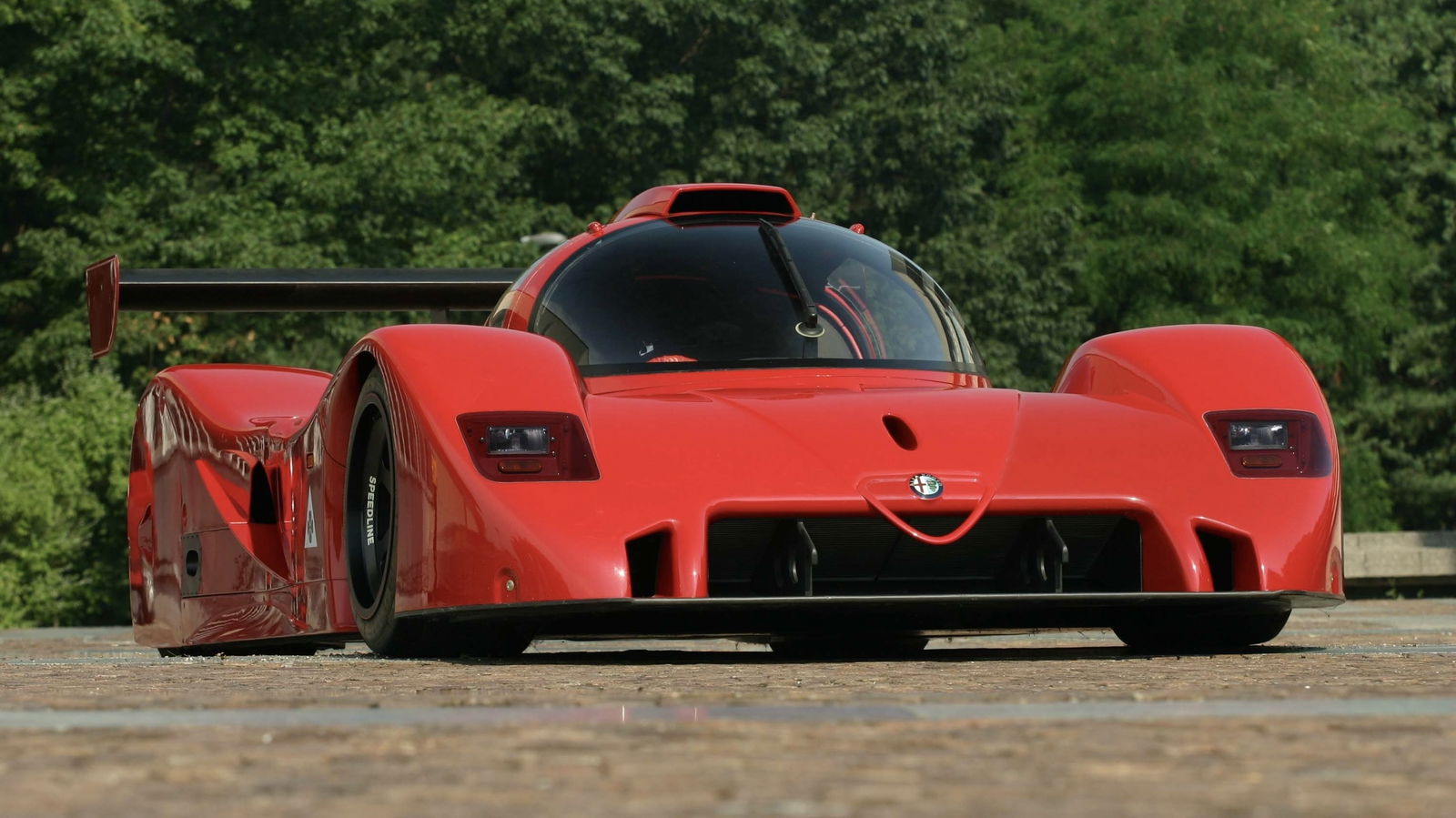10 Cool Race Cars That Never Raced

Motorsport is a pretty expensive business to be involved in – that much is no secret. Companies that enter it, then, will need to be pretty convinced that there’s a good chance of them making a return on that investment when they get down to the business of actually building a car to race with.
But sometimes, things change. Costs can spiral, regulations can be altered at the last minute, or good old-fashioned politics and bickering can rear their ugly head, all of which can leave a race car that’s fairly far along in development suddenly unable to do the very thing it was destined to – race. We’ve trawled the annals of motorsport history for 10 instances where that’s happened.
Toyota GR Yaris WRC (2021)
We’re so accustomed these days to the brilliance of the Toyota GR Yaris that it’s easy to forget it was originally developed to give Toyota a leg up in the World Rally Championship. Essentially an old-school homologation special, by building this racier, three-door Yaris road car, Toyota would have a better base for their rally car in 2021.
Testing began in early 2020, where it was found to be massively quicker than the outgoing WRC car based on the regular Yaris. Hang on? Early 2020? Yep, after just four days of testing had been completed, a ban on testing was implemented by the WRC in response to the pandemic. That left Toyota with too little time to finish developing the car, so it elected to extend the life of the old car for a year and debut the GR Yaris in 2022 when the new Rally1 regulations came into effect.
It was a bit of a shame, because the 2017 to 2021 WRC rules were short-lived but spectacular – hugely powerful, downforce-heavy cars that are arguably as close as we’ve come to a modern equivalent to Group B.
Koenigsegg CCGT

The Koenigsegg CCGT was a planned GT1-class racer developed by a company that hadn’t bothered with motorsport before and hasn’t since. With its European supercar sensibilities and thumping Ford-derived V8, it would have bridged the transatlantic gap between the screaming V12 Aston DBR9s and Maserati MC12s and thunderous V8 Corvettes and Saleen S7s it was set to race against at Le Mans and other tracks.
It was shaping up to be seriously competitive, but not long after testing had begun in 2007, two GT1 rules were changed that dealt a fatal blow to the project: carbon monocoques were banned, and the minimum number of road cars needed for homologation was upped from 20 to an untenable-for-Koenigsegg 350.
The CCGT’s time may yet come, though. In 2023, the one and only prototype was sold at auction, and at the same time, Masters Historic Racing, which runs a series for GT cars of this era, confirmed it’d allow the big ’egg to race in the championship if its owner so desired. So far, though, that hasn’t come to fruition.
Ferrari F50 GT

That Koenigsegg was developed for the second, noughties iteration of the GT1 category – here’s something built for the ’90s original. The Ferrari F50, of course, already had a motorsport link with its F1-derived, structurally-stressed V12, but it could have been a serious racer in its own right.
It was designed to run in the BPR Global GT Series in the mid ’90s against cars like the McLaren F1 and Jaguar XJ220. Allegedly, though, Ferrari was unhappy when Porsche pitched up in 1996 with the 911 GT1, essentially a bespoke prototype racing car exploiting a newly-opened loophole that allowed it to build a tiny handful of road cars for homologation.
Apparently, Ferrari tried to get this rule changed, but when the organising body wouldn’t relent, it cancelled the F50 GT after just three prototypes had been built. A lack of funding and a desire to focus more on its then-rebounding F1 programme are also sometimes cited as reasons for the car’s cancellation, but either way, we sadly never got to hear this particular V12 scream its way down the Mulsanne Straight.
Image: Marty B, CC BY-SA 2.0
BMW M4 DTM (G82)

The transition of the German DTM series from a unique thing that saw the country’s big manufacturers fight it out in bespoke silhouette races, and even had a brief period of convergence with Japan’s equally cool Super GT series, into Just Another GT3 Championship™ has been a sad thing to watch.
That transition began with the departure of Mercedes in 2019, then Audi in 2020, leaving BMW as the only one of the Big Three still committed to building a car to the spectacular ‘Class 1’ ruleset. For 2021, that car was to be based on the then-new, buck-toothed second-gen G82 M4.
Though it was in development, the switch to GT3 rules for 2021 meant it never saw the light of day. Not in real life, anyway. BMW furnished Studio 397, developer of racing sim rFactor 2, with full technical details and drawings of the scrapped car so it could be virtually recreated in-game, and today, that’s the only place you can see what it would have looked like.
Lexus LFA GTE
When Toyota returned to the 24 Hours of Le Mans in 2012 after 13 years away, it was in the LMP1 class, then the top category of prototypes. But it initially had plans for a two-pronged attack on the race, and accompanying World Endurance Championship, with a version of the Lexus LFA developed for the production-based GTE category.
Yes, the LFA, complete with its unbelievable Yamaha-built 4.8-litre V10. We were denied the chance to hear one of the greatest road car engines of all time howl its way through the night at Le Mans in unsilenced racing form. Sorry to ruin your day.
The car got some way along in development, with photos of a prototype floating around the internet at the time, before a 2013 Racecar Engineering story suggested that it was scrapped due to the logistical headaches of running two categories at once. The LFA did have some racing history, though, with various versions running at the Nürburgring 24 Hours over the years, and the Lexus name eventually made it to Le Mans in 2023 with the RC F GT3.
Alfa Romeo SE 048SP

The Group C era of endurance racing in the 1980s and early ’90s saw enormous manufacturer involvement, but there could have been more still. When the formula switched to requiring 3.5-litre engines in 1990, it left the Fiat group’s then-contender, the Lancia LC2, unable to compete without heavy power restrictions.
With Lancia then focusing more on its rally programme, the endurance racing buck was passed to Alfa Romeo, which developed the very uncatchily-named SE 048SP, a funky-looking Group C prototype with a huge grille to feed the unconventional front-mounted radiator and Jaguar XJR-9-style rear wheel spats.
These days, the sole prototype, which now lives in the vaults of Alfa Romeo’s museum in Milan but does get rolled out for occasional public appearances, has a 3.5-litre Ferrari F1 V12 in the back. Depending on who you ask, it was either fitted with that engine in-period when the originally planned V10 was found to be incapable of withstanding the demands of a 24-hour race, or it was swapped out in the years since. Either way, it’s irrelevant, because Fiat pulled the plug in late 1990 in the face of spiralling costs and uncertainty around the future of the Group C class.
Image: Roberto Motta, CC BY-SA 3.0
Porsche LMP2000

After Porsche won the 1998 24 Hours of Le Mans with the loophole-abusing 911 GT1, it looked towards developing a successor, this time for the new breed of Le Mans Prototypes. It took a year off to cook up the LMP 2000, a prototype powered by a development of a V10 engine that it had originally built for a scrapped Formula 1 engine supply programme.
Given Porsche’s track record at Le Mans, it could well have been a serious contender, but we never got to find out. The project was cancelled by higher-ups in the summer of 1999 for budgetary reasons – and possibly because VW Group stablemate Audi was seriously stepping up its own Le Mans programme – although the car was still allowed to be finished for a private shakedown run later that year.
Either way, there are some happy endings to the story. That V10, having failed to appear first in an F1 car and then in a Le Mans Prototype, was developed into the scintillating unit fitted to the Carrera GT road car. As for the sole LMP 2000 prototype, Porsche never officially acknowledged its existence until late 2024, when it was pulled out of storage, recommissioned and allowed to run again, this time on video so the world could finally hear that glorious engine at full beans.
Toyota TF110

Toyota was one of several big-name manufacturers to pull out of F1 in 2009 in the wake of the previous year’s financial crisis, having infamously poured billions into its eight-year-long programme without a single race win to show for it.
However, the decision to leave obviously came quite late, because work was already well underway on its 2010 contender, the TF110. Two chassis had been finished, wearing some radical aero, including a trick double diffuser.
Former Toyota driver and present-day accidental meme Timo Glock is on the record as saying he believed the car could have finally competed for wins, and even titles, but thanks to some irresponsible mortgage lending a few years earlier, we never got to find out. Talk about a butterfly effect.
Image: Morio, CC BY-SA 4.0
Audi Quattro RS 002

Most people with a passing knowledge of motorsport know that several tragic accidents during 1986 led to the banning of the wild Group B era of rallying at the end of that year, but it’s slightly less common knowledge that the category wasn’t long for the world anyway, with plans to fully replace it with a new ruleset called Group S in 1988.
Designed to be more technically advanced and safer than the Group B beasts, and with even looser homologation rules, several manufacturers, including Lancia, Peugeot and Toyota were already well-advanced with developing cars.
Audi, though, had perhaps the maddest of all in the works. Dubbed the Quattro RS 002, it was built on a separate mid-engined prototype version of the original Quattro, and came clothed in a body that looked like a shrink-wrapped Group C racer. When the planned Group S class was cancelled alongside Group B, though, the car became redundant and was resigned to sitting in Audi’s Ingolstadt museum. It was eventually recommissioned in 2016 and now gets occasional public runs, with the late Ken Block getting to have a play with it in 2021.
Jaguar XJ13

Jaguar had made a name for itself at Le Mans in the 1950s with the D-Type, and it sought to keep pace with the rapidly evolving competition in the ’60s with this, the XJ13. Powered by a brand new 5.0-litre dual overhead cam V12, it should have taken on the might of the Ford GT40 and Ferrari 330 in endurance races around the world. It was also utterly, jaw-droppingly gorgeous.
However, a combination of lack of funds and changing regulations – prototype cars were limited to 3.0-litre engines, and Jag didn’t have the wherewithal to build the 50 roadgoing examples needed to classify it as a production car – saw the project killed in 1966.
Jaguar held onto the sole car built, though, running the odd test session and wheeling it out for some filming at the MIRA test track in 1971 to promote the launch of the Series 3 E-Type. It was here that legendary Jaguar test driver Norman Dewis survived a spectacular high-speed accident caused by a puncture, all but destroying the XJ13. Its story still didn’t end there, though: the car was rebuilt to its original specifications and continues to appear at events like the Goodwood Festival of Speed to this day.















Comments
Power to weigh ratio - amazing, one HP per kilogram, and it weights only 750 kilograms! so it also makes a lot of power, even more deadly than the standard MR2!
F50 GT is waifu.
Nice article!
Qian Li
I have seen the Toyota mr2 at the Eifel rallye in germany
oh ok
Nice read - all awesome cars!
Very interesting!
It’s a shame the F50 GT Never made it :(